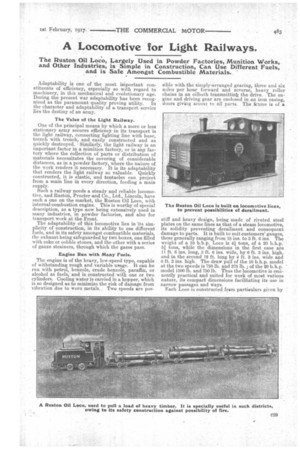A Locomotive for Light Railways.
Page 7

Page 8

If you've noticed an error in this article please click here to report it so we can fix it.
The Ruston Oil Loco, Largely Used in Powder Factories, Munition Works, and Other Industries, is Simple in Construction, Can Use Different Fuels, and is Safe Amongst Combustible Materials.
Adaptability is one of the most important constituents of efficiency, especially so with regard to machinery, in this mechanical and evolutionary age. During the present war adaptability has been recognized as the paramount quality proving utility. In the character and adaptability of a transport service lies the destiny of an army.
The Value of the Light Railway.
One of the principal means by which a more or less stationary army secures efficiency in its transport is the light railway, connecting fighting line with base, trench with trench, and easily constructed and as quickly destroyed. Similarly, the light railway is an important factor in a munition factory, or in any factory where. the collection of parts or distribution of materials necessitates the covering of considerable distances, as in a powder factory, where the nature of the work renders it necessary. It is its adaptability that renders the light railway so valuable. Quickly constructed, it is elastic, and tentacles can project from a main line in every direction, feeding a main supply. Such a railway needs a steady and reliable locomotive, and Ruston, Procter and Co., Ltd., Lincoln, have such a one on the market, the Ruston Oil Loco, with internal-combustion engine. This is worthy of special description, as a type now being extensively used in many industries, in powder factories, and also for transport work at the Front.
The adaptability of this locomotive lies in Its simplicity of construction, in its ability to use different fuels, and in its safety amongst combustible materials, the exhaust being safeguarded by two boxes, one filled with coke or cobble stones, and the other with a series of gauze strainers, through which the gases pass.
Engine Run with Many Fuels.
The engine is of the heavy, low-speed type, capable of withstanding rough and variable usage. It can be run with petrol, benzole, crude benzoic paraffin, or alcohol as fueIsi and is constructed with one or two cylinders. Cooling water is carried in a hopper, which is so designed as to minimize the risk of damage from vibration due to worn metals. Two speeds are pos Bible with. the simply-arranged gearing, three and six miles per hour forward and reverse, heavy roller chains in an oilbath tra.nsmittink the drive. . The engine and driving gear are enclosed in an iron casing, doors giving acces3 to all parts. The kame is of a stiff and heavy design, being made of riveted steel plates on the same lines as tha,t of a steam locomotive, its solidity preventing derailment and consequent damage to parts. It is built to suit customers' gauges, these generally ranging from 18 ins. to 3 ft. 6 ins. The weight of a 10 b.h.p. Loco is 41 tons, of a 20 b.h.p. 5/ tons, while the dimensions in the first case are 11 ft. 6 ins. long, 3 ft. 6 ins, wide, by 6 ft. 3 ins, high, and in the second 12 ft. long by 4 ft. 3 ins, wide and lift. 3 ins. high. The draw pull of the 10 b.h.p. model at the two speeds is 750 lb. and 375 lb.; of the 20 b.h.p. model 1500 lb. and 750 lb. Thus the locomotive is eminently practical and suited for work of most various nature, its compact dimensions facilitating its use in narrow passages and ways.
Each Loco is constructed from partieulars given by the customer, so that any local difficulties may be met and overcome. The net load to be hauled per train per day or hour is ascertained, together with the additional weight of the loaded and empty truck, the maximum speed per hour, the gauge, height and weight of rails per yard, the measurements of the sleepers, the length of track, and nature of its curves and gradients, and particulars of the buffer and draw gear arrangement. , It is quite easy to see that such a locomotive can be used in various directions. Its unique suitability for powder factories has been already pointed out ; it is scarcely less suitable for work in large forests or out-of-the-way country districts in such industries as the timber trade, where there is. bound to be a certain amount of long andlieavy hauling, and where the difficulties of obtaining la,rge supplies of coal and water, and the inflammability of the surroundings, enhance the value of such a locomotive. Cordite, acids, stock piles, limestone and other materials are being hauled by these engines, and they seem eminently suited for quarrying, mining, or shunting purposes. At the present time, it may be stated that delivery after order depends upon the latter's urgency and the work for which it is required as to whether it is of importance nationally.
























